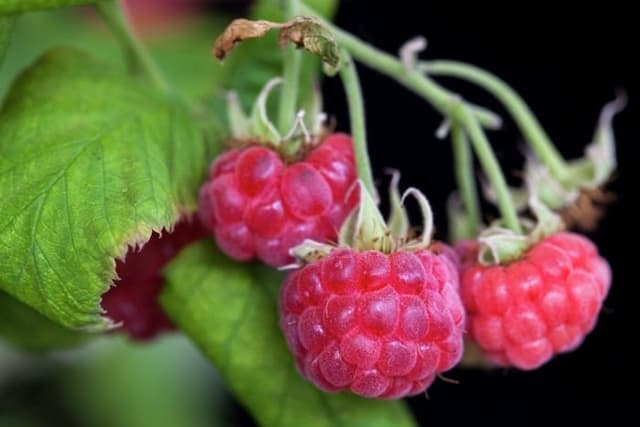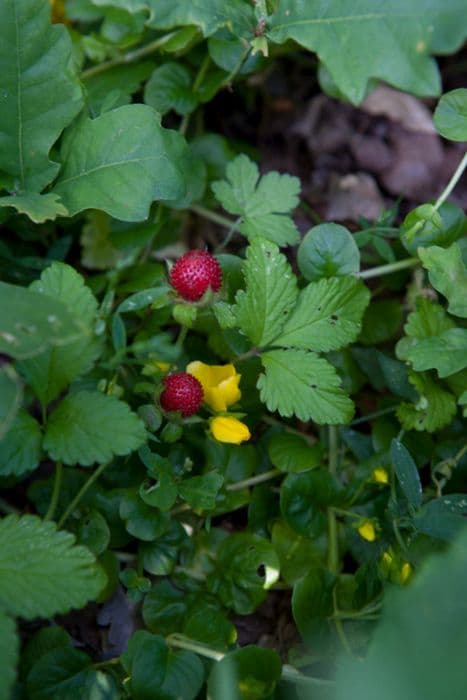Strawberry Fragaria × ananassa 'Redgauntlet' (F)

ABOUT
The Redgauntlet strawberry is a popular cultivar known for its attractive and productive characteristics. It features deep green, trifoliate leaves with a glossy appearance that create a lush foliage backdrop. The plant produces an abundance of white flowers, each with five petals that surround a yellow center, signalling the arrival of fruit. Following the flowers, Redgauntlet strawberries set large, conical berries that are bright red and glossy when ripe. These strawberries are known for their sweet aroma and juicy texture, making them a favorite for fresh eating and culinary use. The berries are dotted with numerous tiny, yellow seeds on their outer surface. The overall appearance of this strawberry variety is one of abundance and vitality, often making it a choice for gardeners who desire both visual appeal and flavor.
About this plant
 Names
NamesFamily
Rosaceae
Synonyms
Garden Strawberry, Cultivated Strawberry
Common names
Fragaria × ananassa 'Redgauntlet'.
 Toxicity
ToxicityTo humans
The Fragaria × ananassa 'Redgauntlet' is commonly known as the strawberry. Strawberries are not toxic to humans and are widely consumed without adverse effects. They are a popular fruit eaten fresh and used in a variety of culinary dishes. There is no inherent toxicity in strawberries, and they do not cause poisoning when ingested by humans.
To pets
The strawberry is not toxic to pets. It is generally safe for pets like dogs and cats to consume strawberries in moderation. However, some pets may have individual allergies or sensitivities, and consuming large quantities may cause gastrointestinal upset due to the natural sugars and fibers present. There are no known toxic compounds in strawberries that would lead to poisoning symptoms in pets when eaten in reasonable amounts.
 Characteristics
CharacteristicsLife cycle
Perennials
Foliage type
Deciduous
Color of leaves
Green
Flower color
White
Height
1 feet 10 inches (25-30 cm)
Spread
1 feet 18 inches (30-45 cm)
Plant type
Herb
Hardiness zones
6
Native area
Americas
Benefits
 General Benefits
General Benefits- Edible Fruit: The 'Redgauntlet' strawberry produces sweet and juicy berries that are used in a wide variety of culinary dishes.
- Aesthetic Appeal: With its lush green foliage and bright red berries, it adds visual interest to gardens and landscapes.
- Pollinator Attraction: The flowers of the strawberry plant attract bees and other pollinators, supporting local ecosystems.
- Easy Cultivation: Strawberries can be grown in a range of soils, are adaptable to various environments, and are suitable for beginner gardeners.
- Space-Efficient: Suitable for small spaces and can be grown in containers, making it ideal for urban or limited space gardening.
- Ground Cover: Works as an effective ground cover, reducing weed growth and soil erosion.
- Harvest Flexibility: Fruit can be picked at various stages of ripeness according to taste preferences and utilization.
- Educational Plant: A popular choice for children's gardens as it can be used to educate on plant growth and fruit development.
 Medical Properties
Medical Properties- Antioxidant effects: Strawberries contain high levels of antioxidants, such as vitamin C, flavonoids, and phenolic compounds, which may help protect cells from oxidative stress.
- Anti-inflammatory properties: The bioactive compounds in strawberries might contribute to reducing inflammation in the body.
- Cardiovascular health: Regular consumption of strawberries has been linked to a lower risk of cardiovascular diseases, possibly due to their ability to improve lipid profiles and reduce oxidative stress.
- Glycemic control: Strawberries have a low glycemic index and may help in the management of blood sugar levels, which is beneficial for individuals with diabetes.
- Cancer prevention: Some studies suggest that the antioxidants in strawberries might have a role in cancer prevention, though more research is needed.
- Brain health: The nutrients in strawberries could play a part in preventing cognitive decline and supporting overall brain health.
 Air-purifying Qualities
Air-purifying QualitiesThis plant is not specifically known for air purifying qualities.
 Other Uses
Other Uses- Fragaria × ananassa 'Redgauntlet' or strawberry plants can be used as natural dyes; their fruit can stain fabric with a pink or light red coloration, which can be used in crafts or textile projects.
- The leaves of the strawberry plant can be used to polish jewelry, as they contain mild acidic properties that can help brighten metals.
- Strawberry fruit can serve as a natural teeth whitener when rubbed against the teeth due to its malic acid content.
- The crushed fruits of strawberries can be added to bathwater for a sweet-smelling, skin-softening bathtime treat.
- When dried, strawberry leaves can be infused into herbal smoking blends as a flavorful and aromatic component.
- The seeds of strawberries can be collected and pressed to yield a basic oil that can be used in homemade skincare formulations.
- Dried strawberries can be included in potpourri mixes to impart a fruity aroma to a room.
- Used strawberry leaves can be placed around garden plants to deter pests, as they dislike the taste and smell of the foliage.
- The hollowed-out middle of a large strawberry can be used as a natural container for serving a sweet or savory mousse or filling.
- Strawberry juice can be frozen into ice cubes and added to drinks for a pop of flavor and a splash of color.
Interesting Facts
 Feng Shui
Feng ShuiThe Strawberry plant, being associated with love and romance, can be used in Feng Shui by placing it in the relationship corner of the home or garden, which is the farthest right-hand corner from the entrance, to attract positive energy and foster harmony.
 Zodiac Sign Compitability
Zodiac Sign CompitabilityThe Strawberry plant is not used in astrology practice.
 Plant Symbolism
Plant Symbolism- Innocence: Strawberries have been associated with purity and innocence in various cultures due to their bright red color and sweet taste.
- Love and Passion: The heart shape and red color of strawberries often symbolize deep affection and strong emotional ties.
- Fertility and Abundance: The fruit's numerous seeds represent plentifulness and the potential for growth and renewal.
- Good Fortune: In some folklore, strawberries are considered a symbol of good luck and prosperity.
- Spring and Rebirth: As a plant that flourishes in spring, strawberries are often associated with new beginnings and the rejuvenation of life.
 Water
WaterThe Redgauntlet strawberry should be watered deeply, ensuring that the water penetrates to the roots, approximately once a week or when the top inch of soil becomes dry. During hot or dry weather, it may require additional watering. Provide about 1 to 1.5 gallons of water per plant per watering session, reducing frequency when rainfall is sufficient. Avoid overhead watering to prevent fungal diseases, and instead use a drip irrigation system or water at the base of the plants. During the winter months, reduce watering since the plants are not actively growing and require less moisture.
 Light
LightStrawberries, like the Redgauntlet variety, thrive in full sun, which means they need at least six to eight hours of direct sunlight daily. The best spot for planting them is an area that receives unfiltered sunlight throughout the day. However, in regions with extremely hot climates, some light afternoon shade can help protect them from excessive heat stress.
 Temperature
TemperatureRedgauntlet strawberries perform best in a temperature range of 60°F to 80°F. They can tolerate temperatures down to 20°F before they suffer damage, and they should be protected if temperatures are expected to fall lower. During the growing season, maintaining an average daytime temperature around 70°F will promote healthy growth and fruiting.
 Pruning
PruningRedgauntlet strawberries benefit from pruning to remove dead or diseased leaves and to thin out overcrowded plants. Pruning improves air circulation, which reduces the risk of fungal diseases. Prune in late winter or early spring before new growth begins. It's also advisable to remove runners throughout the growing season to direct the plant's energy into fruit production rather than vegetative growth.
 Cleaning
CleaningAs needed
 Soil
SoilStrawberry 'Redgauntlet' thrives best in well-draining, loamy soil with a pH between 5.5 and 6.8. A soil mix of one part peat, one part compost, and one part perlite or sand is ideal for optimal growth and fruit production.
 Repotting
RepottingStrawberry 'Redgauntlet' typically doesn't require frequent repotting as they are perennial; however, they may benefit from being replanted every 2-3 years to refresh the soil and promote healthy growth.
 Humidity & Misting
Humidity & MistingStrawberry 'Redgauntlet' prefers moderate humidity levels, typically ranging from 40% to 60%.
 Suitable locations
Suitable locationsIndoor
Place in bright, indirect light; keep soil moist.
Outdoor
Plant in sun, shelter from extreme elements.
Hardiness zone
5-8 USDA
 Life cycle
Life cycleThe life cycle of the Strawberry 'Redgauntlet' begins with seed germination, which occurs in warm, moist soil conditions. Following germination, the seeds develop into small seedlings with a set of true leaves, entering the vegetative growth phase where they establish a robust root system and foliage. As the plants mature, they enter the flowering stage, typically in early to mid-spring, and produce white flowers that are pollinated by insects. After pollination, the flowers develop into red, juicy fruits, the strawberries, which ripen on the plant and are ready for harvest in late spring to early summer. Once fruiting is complete, the plant enters a period of dormancy during colder months, especially if in a temperate zone. The plant may also produce runners, or stolons, which touch ground and can root to form new plants, thus propagating asexually and ensuring the next generation.
 Propogation
PropogationPropogation time
Spring to early summer
The most popular method for propagating 'Redgauntlet' (F), a cultivar of garden strawberry, is through runner division, typically best done in the late summer after the main fruiting period. The plant naturally sends out runners - long stolon with nodes at certain intervals. At these nodes, small plants begin to form and take root when they make contact with the soil. To propagate, gardeners select healthy runner plants that have developed a good root system and sever them from the mother plant, ensuring each new plantlet has ample roots. The small plants are then transplanted to a prepared bed or pot, spaced about 12 to 18 inches (30 to 45 centimeters) apart to allow for growth and air circulation. The transplanted runner should be watered well to help establish it in its new location, ensuring high humidity and avoiding direct sunlight in the first few days to prevent wilting. This method is efficient because it uses the natural reproductive strategy of the strawberry plant and usually ensures a true-to-type clone of the parent plant.









